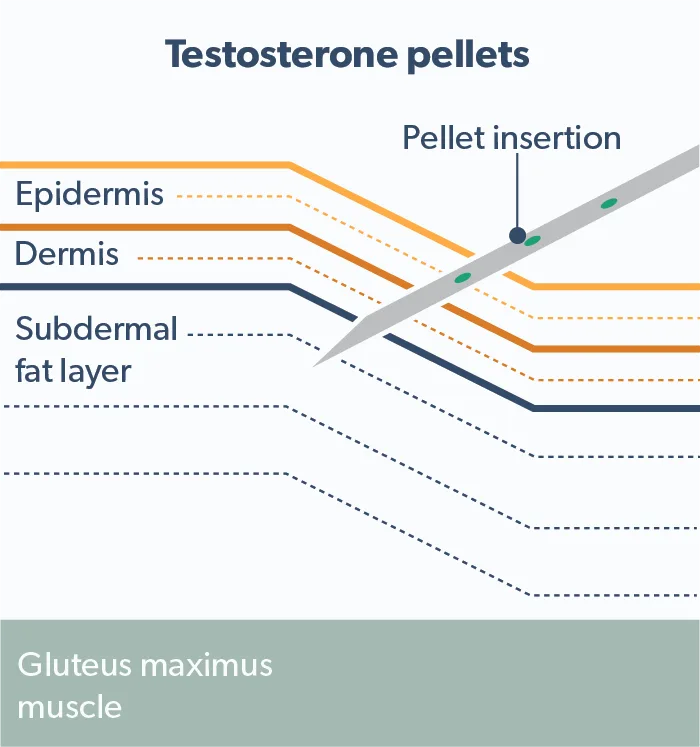Here's what we'll cover
Here's what we'll cover
If you’ve got low testosterone, you might be feeling all sorts of symptoms—fatigue, low libido, maybe even depression. You probably want to fix this, and fast.
Testosterone replacement therapy isn’t for everyone, but it might be a good option for you. It comes in a few different forms, one of which is testosterone pellets. Keep reading to learn all about this often preferred form of boosting testosterone.
What are testosterone pellets?
Testosterone pellets (brand name Testopel®) are used in testosterone replacement therapy (TRT) for treatment of hypogonadism, known as “low T” (low testosterone). Each plastic pellet contains 75 mg of crystalline testosterone. The pellets are placed subcutaneously, below the surface of the skin. Pellet implantation is done through a small incision, usually in the skin of your hips. There, the pellets slowly release testosterone into your body for three to six months.
Testosterone pellets have been used in the United States since 1972, when they were approved by the Food and Drug Administration (FDA) (McCullough, 2014). But they’re not a widely used form of TRT in this country. Most healthcare providers prescribe topical testosterone gel for TRT. Other forms of treatment include testosterone injection, gum (buccal) patches, oral tablets, and nasal gel.

Dosage for testosterone pellets
The FDA recommends dosing three to six pellets (225-450 mg) every 3–6 months for hypogonadal men. For some men, a higher dose of testosterone may be necessary. Some studies show that a dose of 10 pellets (750 mg) produces better results. The dosage can depend on your weight as well. Thin men may require a lower dosage, while heavier men may require a higher dosage to achieve the right hormone levels (McCullough, 2014).
Advantages of testosterone pellets
According to a study that looked at different forms of TRT, men are about equally satisfied with testosterone injections, gels, and pellets. But pellets do have certain advantages over other forms of TRT (Kovac, 2014):
Pellets may be considered more convenient and easier to use than gels and injections.
The slow, steady release of testosterone means you’ll likely experience fewer mood swings and changes in your level of energy.
There’s no danger of the subcutaneous testosterone rubbing off on others, as there is with testosterone gel. This can be a real concern if you’re in physical contact with women and children, as they might suffer serious side effects if they come into contact with testosterone gels.
Disadvantages of testosterone pellets
While testosterone pellets have a lot of advantages, they’re not used as often as gels or injections. This is because they come with some disadvantages (McCullough, 2014; Endo Pharmaceuticals, 2020):
You’ll need to visit a healthcare provider’s office to have the pellets implanted.
The insertion site may be painful.
If it’s necessary to take the pellets out, removal is difficult.
There are rare cases of extrusion, where the pellets work their way out of the skin.
Who needs testosterone replacement therapy?
Healthcare providers may prescribe TRT for men who are diagnosed with low testosterone levels. This is usually defined as levels below 300 ng/dl (Mulhall, 2018). But it’s important to bear in mind that normal testosterone levels change throughout your life. Levels of testosterone peak at around age 19 and then gradually decline over the years. So a level considered low for a 20-year-old might be considered normal for a man of 70.
Symptoms of low testosterone
Symptoms of hypogonadism, or low T, include (Mulhall, 2018):
Low energy
Fatigue
Reduced motivation
Decreased sex drive (low libido)
Changes in the ability to get an erection
Does TRT work?
There’s a fair amount of evidence that, in men with hypogonadism, TRT improves sexual desire, erectile function, and sexual satisfaction (Ponce, 2018). One large-scale review also found through-the-skin (transdermal) TRT slightly increased muscle mass (Skinner, 2018).
Potential risks and side effects of TRT
As one of the two main male sex hormones (androgens), testosterone is a potent drug. The effects of testosterone are felt in almost every one of your body’s systems. The possible side effects of TRT include infertility, shrinking of testicles, acne, oily skin, raised cholesterol levels, and an increase in breast size.
Although it hasn’t been proven, TRT may also increase risk of cardiovascular events such as heart attacks and stroke, heart disease, prostate cancer, increase in number of red blood cells, and benign prostatic hyperplasia (BPH) (Grech, 2014).
If you think you might have low testosterone, follow the medical advice of your healthcare provider.
DISCLAIMER
If you have any medical questions or concerns, please talk to your healthcare provider. The articles on Health Guide are underpinned by peer-reviewed research and information drawn from medical societies and governmental agencies. However, they are not a substitute for professional medical advice, diagnosis, or treatment.
Endo Pharmaceuticals. (2020). Testopel (testosterone pellets). Prescribing information and important safety information. Retrieved from https://www.testopel.com/#isi
Grech, A., Breck, J., & Heidelbaugh, J. (2014). Adverse effects of testosterone replacement therapy: an update on the evidence and controversy. Therapeutic Advances in Drug Safety , 5 (5), 190–200. doi: 10.1177/2042098614548680. Retrieved from https://pubmed.ncbi.nlm.nih.gov/25360240/
Kovac, J. R., Rajanahally, S., Smith, R. P., Coward, R. M., Lamb, D. J., & Lipshultz, L. I. (2014). Patient satisfaction with testosterone replacement therapies: the reasons behind the choices. The Journal of Sexual Medicine , 11 (2), 553–562. doi: 10.1177/2042098614548680. Retrieved from https://pubmed.ncbi.nlm.nih.gov/25360240/
McCullough, A. (2014). A review of testosterone pellets in the treatment of hypogonadism. Current Sexual Health Reports , 6 (4), 265–269. doi: 10.1007/s11930-014-0033-7. Retrieved from https://www.ncbi.nlm.nih.gov/pmc/articles/PMC4431706/
Mulhall, J. P., Trost, L. W., Brannigan, R. E., Kurtz, E. G., Redmon, J. B., Chiles, K. A., et al. (2018). Evaluation and management of testosterone deficiency: AUA Guideline. The Journal of Urology , 200 (2), 423–432. doi: 10.1007/s11930-014-0033-7. Retrieved from https://pubmed.ncbi.nlm.nih.gov/25999802/
Ponce, O. J., Spencer-Bonilla, G., Alvarez-Villalobos, N., Serrano, V., Singh-Ospina, N., Rodriguez-Gutierrez, R., et al. (2018). The efficacy and adverse events of testosterone replacement therapy in hypogonadal men: A systematic review and meta-analysis of randomized, placebo-controlled trials. The Journal of Clinical Endocrinology & Metabolism , 103 (5), 1745–1754. doi: 10.1210/jc.2018-00404. Retrieved from https://pubmed.ncbi.n lm.nih.gov/29562341/
Skinner, J. W., Otzel, D. M., Bowser, A., Nargi, D., Agarwal, S., Peterson, M. D., et al (2018). Muscular responses to testosterone replacement vary by administration route: a systematic review and meta-analysis. Journal of Cachexia, Sarcopenia and Muscle , 9 (3), 465–481. doi: 10.1002/jcsm.12291. Retrieved from https://pubmed.ncbi.nlm.nih.gov/29542875/










